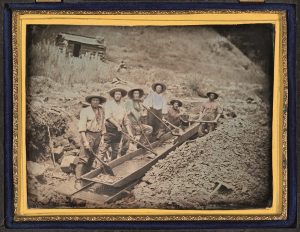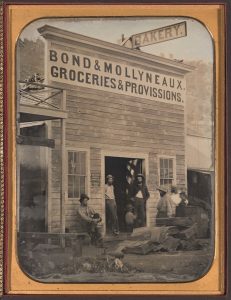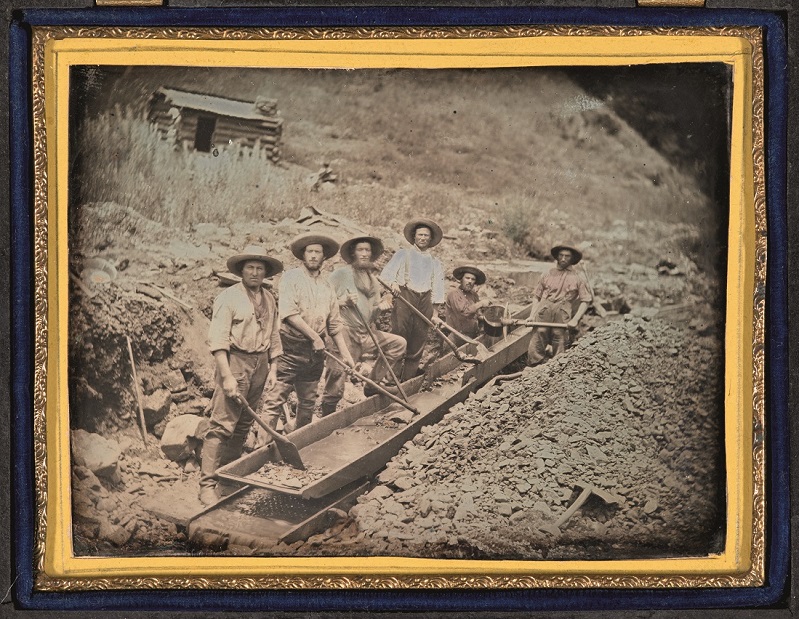Golden Prospects: California Gold Rush Daguerreotypes
to Open at Nelson-Atkins
Exhibition Documents Significant Event in American History
Kansas City, MO. Aug. 20, 2019–From the moment the first cry of “Gold!” was heard at Sutter’s Mill in 1848, thousands of people made the journey to California to find their fortune. Daguerreotypists also made their way west, not in search of gold, but to capitalize on the ready market of potential customers. Golden Prospects: California Gold Rush Daguerreotypes opens at The Nelson-Atkins Museum of Art in Kansas City Sept. 6.

“The California Gold Rush was the first broadly significant event in American history to be documented in depth by photography,” said Julián Zugazagoitia, Menefee D. and Mary Louise Blackwell CEO & Director of the Nelson-Atkins. “This revealing exhibition utilizes the Nelson-Atkins deep collection of American daguerreotypes, providing an insightful look at this historic event through the eyes of the earliest photographers.”
The exhibition features more than 90 daguerreotypes (and ambrotypes) of the California gold rush. Studios were established in the larger cities, but some adventuresome daguerreotypists traveled into the gold fields in photographically outfitted wagons. Images were taken of miners working in the gold fields using various mining technologies, large-scale riverbed and hydraulic mining operations, small gold towns, and the rapidly expanding cities of San Francisco and Sacramento. Inside, studio portraits were taken of miners.

“The California gold rush exposed many complicated issues that have continued relevance today, including immigration policy, water rights, and environmentally devastating mining practices,” said Jane Aspinwall, Associate Curator, Photography. “California daguerreotypists were documenting essentially new territory: both the physical landscape and the region’s unprecedented mix of races and nationalities were unfamiliar.”
Gold rush daguerreotypes provide an extraordinary glimpse into the transformation of the American West: the evolution of mining technology, the diversity of nationalities and races, the growth of cities and towns, and the people who participated in these activities—while revealing a high level of technical and artistic accomplishment. The exhibition is accompanied by a catalogue. An audio tour that tells the stories of the Gold Rush is easily accessed on the Smartify app. It runs at the Nelson-Atkins through Jan. 26, 2020. It then travels to the Peabody Essex Museum (4/4–7/12/20) and Yale University Art Gallery (8/28–11/29/20).
Image captions: Unknown maker. Gold miners with sluice, California, ca. 1852. Daguerreotype, quarter plate, 3 1/4 × 4 1/4 inches. The Nelson-Atkins Museum of Art, Kansas City, Missouri, Gift of Hallmark Cards, Inc., 2005.27.116.
Unknown maker. Bond & Mollyneaux groceries and provisions, California, ca. 1851. Daguerreotype, whole plate, 8 1/2 × 6 1/2 inches. The Nelson-Atkins Museum of Art, Kansas City, Missouri, Gift of the Hall Family Foundation, 2008.6.3.
Exhibition credit line: Organized by The Nelson-Atkins Museum of Art. This exhibition is supported by the Hall Family Foundation.
The Nelson-Atkins Museum of Art
The Nelson-Atkins in Kansas City is recognized nationally and internationally as one of America’s finest art museums. The museum, which strives to be the place where the power of art engages the spirit of community, opens its doors free of charge to people of all backgrounds. The museum is an institution that both challenges and comforts, that both inspires and soothes, and it is a destination for inspiration, reflection and connecting with others.
The Nelson-Atkins serves the community by providing access to its renowned collection of more than 41,000 art objects and is best known for its Asian art, European and American paintings, photography, modern sculpture, and new American Indian and Egyptian galleries. Housing a major art research library and the Ford Learning Center, the Museum is a key educational resource for the region. In 2017, the Nelson-Atkins celebrates the 10-year anniversary of the Bloch Building, a critically acclaimed addition to the original 1933 Nelson-Atkins Building.
The Nelson-Atkins is located at 45th and Oak Streets, Kansas City, MO. Hours are Monday, Wednesday, 10 a.m.–5 p.m.; Thursday/Friday, 10 a.m.–9 p.m.; Saturday, 10 a.m.–5 p.m.; Sunday, 10 a.m.–5 p.m. The museum is closed Tuesday. Admission to the museum is free to everyone. For museum information, phone 816.751.1ART (1278) or visit nelson-atkins.org.
For media interested in receiving further information, please contact:
Kathleen Leighton, Manager, Media Relations and Video Production
The Nelson-Atkins Museum of Art
816.751.1321
kleighton@nelson-atkins.org
